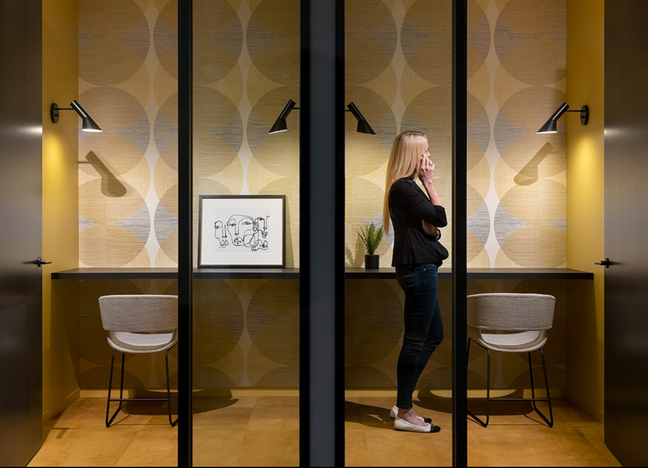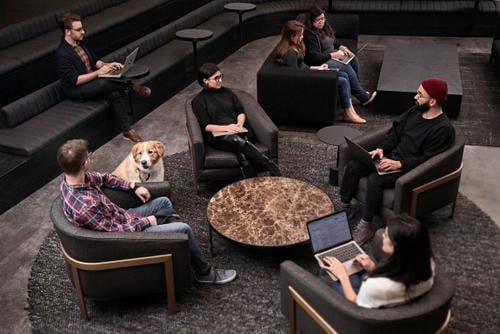THE ONBOARDING JOURNEY
AN INTERACTIVE ROADMAP FOR DEALER PARTNERS
TAKING THE WHEEL
Welcome to the essential journey of onboarding—the critical path that transforms promising candidates into fully engaged members of our team.
We recognize that finding stellar talent is merely the first leg of our trip together. The onboarding process is where the rubber meets the road, setting the course for our new colleagues to become productive and happy contributors to our shared goals.
It's an open secret that while the importance of a seamless onboarding experience is well-known, it's often a bumpy ride. Statistics show a split in the road: only 52% of new hires are currently reaching their destination feeling well-equipped, with others encountering detours of confusion or disorganization. A rocky start can leave our team members lost or stranded, making it harder for them to journey with us for the long haul.
In fact, disengagement can be a costly detour, siphoning off up to 18% of an employee's potential in value. Closing these gaps is crucial for us as leaders to ensure we're all driving in the same direction, with everyone ready to go the distance.
For remote and hybrid workers, the road can be even more challenging, which is why our onboarding process is designed like a high-performance vehicle, equipped for all conditions, ensuring every team member can navigate the landscape of our organization, regardless of where they're seated.
The great news? You've got a full tank and a team of navigators. MillerKnoll, alongside a collective of Dealer Partner expertise, has crafted an interactive roadmap—a compendium of the best practices and clear signposts to steer you towards onboarding success!
In our comprehensive Onboarding Guidebook, we have meticulously curated a suite of essential tools designed to streamline and enrich your onboarding journey. These tools are categorized into three distinct sections: "Accelerators," "Pit Stops,"and "Navigators."
PIT STOP
Pit Stop offers a collection of measurable indicators to help you stay on course, ensuring that your onboarding objectives are consistently met and aligned with organizational goals. It's your go-to for evaluating progress and making necessary adjustments.
ACCELERATOR
Accelerator is packed with innovative tips and tricks to enhance your onboarding process. This section is aimed at supercharging your approach, providing creative and effective strategies to engage and integrate new hires more efficiently and effectively.
NAVIGATIOR
Navigation presents an array of external resources that you can tap into along your journey. It includes links to industry best practices, expert insights, and external training resources, equipping you with a broader perspective and additional tools to complement your onboarding initiatives.

Employees who strongly agree their
onboarding process was exceptional are
nearly three times as likely to say they have
the best possible job.
NAVIGATION SUPPORT:
ESTABLISHING A PLAN
The cadence of the training schedule should be customized to what they need to learn as they are integrated into your organization. At first, the large majority of their activities will be centered around training, but gradually they will start doing more of the work and spend less time training. Make sure to customize the schedule to the learning pace of the new hire: some learn more quickly, while others need more time to absorb new knowledge. This training schedule should naturally transition over time into the kind of professional development you offer every employee.
BEFORE THEY START
FIRST DAY
DAY TWO
FIRST WEEK
Before a new employee’s first day - The first day of a new job can be overwhelming, so 15 or more days before your new employee starts, try to:
- Schedule their welcome meeting
- Set up a company email
- Answer any questions they have
- Explain virtual meeting guidelines (if applicable)
- Provide all necessary technology, and embed them in relevant company systems
- Supply date, time, and dial-in information (if applicable) for first-day meetings
New employee’s first official day - Your goal for your new employee’s first day is to outline the week ahead while making them feel welcome. Here are some ways to do so:
- Educate them on how to use company systems
- Invite them to team events
- Detail the remainder of the week’s meetings
- Introduce them (with their information and title) to relevant teams, coworkers, and partners
- Outline organizational processes and resources such as benefits, time sheets, and HR access
Your new hire is now familiar with their new role, company processes, and the people they’ll work with. Now, help them acclimate to their new work environment:
- Review their job description, duties, and what’s expected of them
- Discuss ways you can most effectively work with them
- Clarify the week’s schedule and confirm relevant training opportunities
- Answer emerging questions about organizational processes and role-relevant workflows
New employee’s first week - Now that you’ve eased your new hire into your workplace and their new role, it’s time to set a cadence:
- Pair them up with a dedicated onboarding partner
- Review the company’s mission, values, and goals
- Supply essential resources, including brand materials
- Schedule check-ins to review onboarding progress and discuss questions and feedback
- Provide a challenging yet attainable and ultimately meaningful assignment to show them what they can expect
FIRST MONTH
SECOND MONTH
REGULAR FOLLOW UP
New employee’s first month - At this point, your new hire knows what’s expected of them and has the resources they need to succeed. Put them to work on the tasks that make up their role, and be sure to:
- Check in and provide regular feedback
- Assign and introduce them to a formal mentor
- Discuss successes and improvement areas from their first assignment
- Establish clear 6-month and annual performance goals
New employee’s second month and beyond - Experts agree that it can take up to a year for new employees to acclimate to their new work environment. As you learn your new hire’s work style over time:
- Celebrate their accomplishments
- Ensure their workload is consistently manageable
- Provide cross-organizational training opportunities
- Note the tasks and projects they enjoy and those they wish to improve at
- Share feedback on their onboarding experience with your HR, IT, and recruiting teams.
Check in with your new employee frequently to assess their progress, address any challenges, and provide support as needed. This could be through weekly check-ins or feedback sessions. Regular follow-ups can help you promptly address any issues and provide ongoing support, thereby enhancing your new hire’s learning experience and job satisfaction. These check-ins can also be an opportunity for you to gauge the effectiveness of your training approach and make changes if necessary.
PIT STOP
Each section in this guidebook is designed to provide managers with the knowledge and tools necessary to create a structured and effective onboarding process. Use these Pit Stops throughout as a practical framework for evaluating the progress and success of new hires at each stage of their onboarding journey.
THE PRE-BOARDING STAGE sets the tone for the entire employee experience. It's crucial to make a positive first impression, ensuring the new hire feels welcomed and prepared even before their first day. This phase is about laying the groundwork for a smooth transition into the company.
MATRIX FOR EVALUATION
- Communication Efficiency: Timeliness and clarity of pre-arrival communication.
- Readiness of Workspace: The workstation and tools are fully set up before the arrival.
- Team Preparedness: The current team's readiness to welcome and integrate the new hire.
Rank | Communication Efficiency | Readiness of Workspace | Team Preparedness |
1 | No communication or highly unclear. | No workstation setup; missing essential tools. | Team unaware of new hire; no buddy assigned. |
2 | Minimal communication; lacks clarity. | Partial workstation setup; missing some tools. | Team partially informed; buddy assigned but unprepared. |
3 | Adequate communication; some details missing. | Workstation mostly set up; all essential tools provided. | Team informed; buddy assigned and somewhat prepared. |
4 | Good communication; clear and informative. | Workstation fully set up; welcoming atmosphere. | Team well-informed; buddy prepared and enthusiastic. |
5 | Excellent, personalized communication; very clear and welcoming. | Workstation fully set up with personal touches; all tools and access ready. | Team fully briefed and excited; buddy proactively engaged. |
THE FIRST WEEK is pivotal in building the new hire's understanding of their role, the company culture, and their place within the team. It's a period of intensive learning and relationship-building.
MATRIX FOR EVALUATION
- Orientation Engagement: The new hire's participation and engagement during orientation.
- Understanding of Role: Clarity on job responsibilities and initial comfort in role-specific tasks.
- Team Integration: Ease of integrating with the team and initial relationship-building.
KEEP GOING! We encourage you to use these as a jumping off point to create your own criteria. Create one for each step of your onboarding plan.
Rank | Orientation Engagement | Understanding of Role | Team Integration |
1 | Disengaged; shows no interest in orientation. | Lacks understanding of basic job duties. | No effort to integrate; avoids team interactions. |
2 | Minimal engagement; passive in sessions. | Partial understanding; needs frequent clarification. | Limited effort to integrate; interacts only when necessary. |
3 | Adequately engaged; participates in discussions. | Understands key responsibilities; occasionally seeks help. | Makes an effort to integrate; interacts with team members. |
4 | Actively engaged; asks questions and shows interest. | Clear understanding; proficient in key tasks. | Actively integrates; builds relationships with team members. |
5 | Highly engaged; shows enthusiasm and deep interest. | Excellent grasp of role; demonstrates initiative in tasks. | Fully integrated; forms strong connections with the team. |
The manager-employee relationship is the most
important relationship at every stage of the employee
journey. Gallup has found that the manager accounts
for 70% of the variance in team engagement.

FILLING UP THE TANK:
THE ROLE OF THE MANAGER




Prepare them for the POSITION
As a manager, you have the most in-depth knowledge of the job requirements of a new hire, and the dynamics of the team they’re joining. To set your new employee up for success, you need to make sure they have the necessary tools and information from the get-go.
DETAIL THE job description
This document should include any specific tasks, responsibilities, and expectations you have for your new employee within the first three months. You can reference the job description used to hire for the role to create this document, but it should be refined based on any new information you have. This step is crucial, as it provides the new hire with clarity about their role and what is expected of them. It also serves as a reference point for future performance evaluations.
Establish performance metrics
Next, put together performance metrics that align with the job description. These metrics should be measurable, relevant, and achievable, such as the completion of various trainings, adherence to timelines, number of tasks completed, etc. These metrics should provide a clear path for the new hire to understand what success looks like in their role. They should also help you to objectively assess your new hire’s performance and provide constructive feedback.
Plan a progressive training schedule
Design a training schedule that progressively helps your new hire understand their responsibilities and achieve their goals. This could include a mix of on-the-job training, workshops, and mentorship programs. This step is important as it ensures that the new hire is gradually introduced to their role and responsibilities, reducing the risk of overwhelm and increasing their confidence and competence.
ACCELERATOR
4 KEY STEPS FOR SETTING EXPECTATIONS
ONE : PROVIDE CLARITY
Managers not only set the stage for individual success but also harmonize the collective efforts towards the organization's goals. Their leadership is crucial in demarcating roles that align with the company’s strategic direction and in fostering an environment where each employee understands their contribution to the broader team.
When employees know their roles and responsibilities, they are more likely to feel empowered and motivated in their work. Furthermore, role clarity can decrease stress levels as employees will no longer have to worry about whether they are meeting expectations.The furniture business intensifies this need as there are so many moving parts and disciplines required to complete a successful project.
When Managers can properly communicate role clarity and expectations it takes the stress and confusion out of the equation.Providing employees with absolute certainty about their main tasks and offering context shows how their individual responsibilities fit into the organization’s bigger picture.
These specific responsibilities might include:
- Tasks: Detail the precise activities that fall within an employee's remit.
- Deliverables: Outline the outcomes each role should achieve.
- Processes: Explain the methods and procedures to be followed.
- Goals: Identifying the objectives aligned with the organization's vision.
- Key Performance Indicators (KPIs): Setting benchmarks to measure success and progress.
When role clarity is properly communicated an employee will know their objectives, what their colleagues’ roles involve, and how they mesh together for business success. Like cogs in a wheel.
TWO : PREVENT CONFUSION
Conversely, a lack of role clarity can have detrimental effects, a challenge that is more prevalent than often perceived. Surveys indicate that only about half of employees feel that their role expectations are clear. Fluctuating performance goals and nebulous accountability create a fertile ground for confusion, leading to:
- Task Redundancy: Where multiple employees inadvertently cover the same tasks, leading to inefficiency.
- Miscommunication: Which can result in errors and project delays.
- Interpersonal Friction: As uncertainty in roles can lead to disputes among colleagues.
In the tightly knit furniture industry, where talent acquisition and retention are particularly challenging, role confusion can be costly, propelling turnover and the loss of valuable resources. Organizations that excel in articulating and conveying roles and responsibilities are better positioned for sustained success.
THREE: STAY CONSISTENT
Understanding the importance of role clarity is one thing; implementing it effectively is another. While the solution may seem straightforward, execution requires a strategic approach and consistent communication.
- Be clear about expectations.It is important to know what you expect from your team members. This way, they will know exactly what they need to do in order to meet expectations.
- Communicate frequently. In order to avoid confusion, it is important that you communicate often with your team. This way, everyone will be on the same page and there will be no confusion.
- Keep it simple. When creating roles, make sure to keep them simple and easy to understand.This isn’t always easy with all the different disciplines in the furniture industry but focusing on “simple” helps everyone.
- Clear Job Description. Give the employee a job description with clear and easy to understand responsibilities. This give the employee an easy to understand playbook.
FOUR : CONSISTENTLY ASK FOR FEEDBACK
Set a series of formal check-in’s on your calendar and make a point to “pop-in” frequently. When interacting with your new hire, ask them lots of questions to help them open up to you. Here are a few examples to start with:
- How are you settling into your role?
- Are there any aspects of this process you’re finding challenging?
- Do you feel you have a clear understanding of your responsibilities and expectations?
- Are there any areas of your job where you would like more training or support?
- How comfortable do you feel with the team dynamics?
- Do you feel you have all the resources and tools you need to perform your job effectively?
- Do you have any suggestions for improving the onboarding process based on your experience?
If your employee raises any concerns or conveys that the onboarding process isn’t going well, it’s important to actively listen and take their complaints seriously. Make sure they feel heard and understood and ask clarifying questions if necessary. Then, express your commitment to addressing their concerns.
You could say, “I hear you. What you’re saying is that you still feel confused about how the payments tool works so it’s difficult for you to submit the expense report. Thank you for sharing that, and I’ll get Jon to give you another demo.” This proactive approach demonstrates that you value their input and are committed to their success in the organization.

“Everyone talks about how work is changing. Let’s talk about what to do about it. We have a once-in-a-generation opportunity to redefine the workplace. Our approach addresses the human needs of employees to improve their wellbeing, fosters a sense of community and connection, and helps organizations navigate, prepare, and design for change.”
...starting with ourselves.
THE LAY OF THE LAND:
INTRODUCING OUR INDUSTRY
The commercial furnishings industry is a dynamic field that encompasses the design, production, and sale of furniture and related products for commercial spaces. As a MillerKnoll Dealer Partner, your focus within this industry is on providing high-quality, innovative furnishings that cater to the evolving needs of workspaces, educational institutions, healthcare facilities, and other commercial environments.
Here is a detailed overview and some tips for managers to effectively introduce new hires to this industry:

CORE PRODUCTS + SCOPE
The commercial furnishings industry offers an extensive catalog of products, including modular office systems, ergonomic seating, versatile tables, and smart storage solutions, along with a myriad of accessories to complement commercial spaces. Services extend beyond mere product sales to encompass space planning, personalized design consultation, product customization to client specifications, and dedicated after-sales support. These services are crucial for creating tailored environments that not only look good but also promote well-being and productivity in the workplace.
Market DYNAMICS
This industry serves a diverse range of markets, from corporate offices seeking to embody their brand in their workspace, to small businesses needing cost-effective solutions, to sectors like hospitality, education, and healthcare, each with their unique requirements. The market is molded by both global and local trends, which dictate design preferences and operational needs, while regional regulations and standards ensure products meet specific safety and quality benchmarks. Understanding these market nuances is essential for delivering relevant and compliant furnishing solutions.


Technological Advancements
As technology becomes more ingrained in our daily lives, the commercial furnishings industry is not far behind. Modern furniture often comes with built-in technology, such as charging ports, and is increasingly interactive, with adjustable features controlled via smartphone apps. Virtual reality (VR) is revolutionizing space planning, allowing clients to visualize potential layouts in a simulated 3D environment, while augmented reality (AR) is helping to showcase how specific products could look in a client's existing space. Embracing these technological advances enhances customer engagement and satisfaction.
Sustainability
Sustainability is rapidly transitioning from a buzzword to a business imperative in the commercial furnishings industry. There is a significant push towards using recycled materials, employing processes that reduce environmental impact, and designing products that contribute to the sustainability goals of buildings, such as LEED certification. Furthermore, end-of-life programs for furniture, which focus on recycling or repurposing old pieces, are becoming a standard part of the product lifecycle, reflecting the industry's commitment to environmental stewardship.


Competition and Collaboration
The commercial furnishings industry is marked by intense competition, with a vast array of players from niche boutique firms to expansive global corporations. Success often hinges on the ability to collaborate effectively with a network of professionals, including architects, interior designers, contractors, and even the clients themselves, to deliver comprehensive and cohesive solutions. This collaborative approach ensures that the final product not only meets the functional requirements but also the aesthetic and strategic objectives of the client’s business.
ACCELERATOR
ENTERING THE WORLD OF FF&E CHECKLIST :





INTRODUCE THE BRAND & LEGACY
- Share the history and values of your Dealership and MillerKnoll, highlighting its reputation for quality and design excellence.
- Explain how the partnership with MillerKnoll positions the dealer to offer some of the best products in the industry.
PROVIDE COMPREHENSIVE PRODUCT TRAINING
- Offer in-depth training on product lines, including the unique features and benefits of different furniture systems and pieces.
- Encourage hands-on experience with the furniture to understand its functionality and design nuances.
EMPHASIZE THE IMPORTANCE OF DESIGN
- Discuss the role of aesthetics in the commercial furnishings industry and how it impacts client satisfaction and workplace productivity.
- Introduce the concept of human-centered design, which is a hallmark of MillerKnoll’s philosophy.
EMPHASIZE THE IMPORTANCE OF DESIGN
- Demonstrate the use of software and tools for space planning, inventory management, and/or customer relationship management.
- Discuss how technology can create smarter workspaces and enhance the user experience.
ENCOURAGE SUSTAINABILITY
- Educate new hires on the sustainability initiatives of MillerKnoll & your Dealership. Explain how they contribute to a greener planet.
- Explain how sustainable practices can be a selling point and add value to client proposals.




CONNECT THE ROLE WITH THE INDUSTRY
- Provide role-specific training so new hires understand their responsibilities and how they fit into the broader industry context.
- Tailor the training to cover sales techniques, design principles, project management, or customer service as appropriate.
FOSTER INDUSTRY KNOWLEDGE
- Encourage keeping abreast of industry trends, market research, and competitor analysis.
- Promote attendance at trade shows, webinars, and continuing education opportunities.
Nurture Client-Focused Mindset
- Instill a client-focused approach, emphasizing the importance of understanding and meeting client needs.
- Role-play client interactions and problem-solving scenarios to build confidence and skills.
CULTIVATE RELATIONSHIPS & NETWORKING
- Highlight the importance of building relationships with stakeholders, including manufacturers, designers, and clients.
- Encourage networking within the industry to foster partnerships and collaboration.
By combining knowledge of the industry with an understanding of your Dealership and MillerKnoll’s unique position in the market, managers can provide new hires with a solid foundation to succeed in the commercial furnishings industry. It’s about equipping them with the right tools, knowledge, and mindset to thrive in a competitive and ever-changing environment.
PIT STOP
In the Furniture, Fixtures, and Equipment (FF&E) industry, the role of the dealer is pivotal. A thorough understanding of these areas is essential for a new hire to feel confident in their role to successfully navigate the complexities of the industry.
MATRIX FOR EVALUATION
- Industry Knowledge: This refers to the new hire's understanding of the broader FF&E industry, including its history, key players, market dynamics, and current trends. It encompasses awareness of industry standards, regulatory considerations, and the competitive landscape.
- Product Understanding: This criterion evaluates the new hire's knowledge of the specific products and services offered in the FF&E sector. It includes an understanding of product features, benefits, applications, and limitations. It also covers knowledge about product sourcing, manufacturing processes, and quality standards.
- Understanding the Dealer’s Role: This criterion focuses on the new hire's comprehension of the specific role and responsibilities of a dealer in the FF&E industry. This includes understanding the dealer's position as a mediator between manufacturers and clients, the importance of maintaining strong relationships with both, and the ability to manage the logistical and financial aspects of transactions. It also involves insight into how a dealer adds value through services like customization, design advice, and project management.
Rank | Industry Knowledge | Product Understanding | Understanding of Dealer's Role |
1 | Unaware of basic industry terms and trends. | Lacks knowledge of basic products and services. | Does not understand the fundamental role of the dealer in the industry. |
2 | Basic understanding of some industry terms; misses key trends. | Familiar with some products but lacks depth in understanding. | Has a rudimentary understanding of the dealer's role; misses finer details. |
3 | Good grasp of industry terms and aware of current trends. | Understands most products and services; needs improvement in specifics. | Understands the dealer's role well; grasps most aspects of the business. |
4 | Strong understanding of industry terms and trends. | Has detailed knowledge of products and services; minor gaps in understanding. | Has a comprehensive understanding of the dealer's role and its importance in the industry. |
5 | Expert-level understanding of the entire FF&E industry. | Deep, nuanced understanding of all products and services. | Fully comprehends the dealer's multifaceted role and its strategic importance in the industry. |
“Companies with positive, vibrant cultures attract the best talent to their teams and produce better products and services since their employees are more motivated to give 100% daily. A stellar workplace culture leads to a better work environment, improved employee engagement, and a better representation of a company's mission.”
GAINING TRACTION:
CULTURAL INTEGRATION
The journey of integrating a new hire into the fabric of a company begins with a clear articulation of the company's culture. Managers play a critical role in this process, serving as the bridge between the new employee and the organization's ethos and values.
A manager's ability to clearly articulate the nuances of the company's culture sets the foundation for a new hire's journey within the organization. They serve as the narrator of the company's story, offering rich context and living examples of the culture in action. It's the manager's responsibility to ensure that new team members are not just familiar with, but fully immersed in, the company's vision, operational principles, and the unwritten social norms that guide behavior within the organization.
There are a variety of different approaches to ensure a new employee finds meaning and purpose in the existing cultural landscape of your company. By implementing these strategies, managers can help new hires not only understand the company culture but become active participants and contributors to it. The goal is to foster an environment where new employees feel valued, understood, and integral to the company's identity and mission.




PROVIDE A WARM WELCOMING
- Arrange a personalized welcome that might include company-branded swag or a welcome note signed by the team, which immediately instills a sense of belonging.
- A manager can personally deliver a welcome message, arrange a team lunch, or create a welcoming committee to make new hires feel at home.
- Introduce new hires to the workspace and team, perhaps using a scavenger hunt or interactive map to make the tour more engaging.
ARTICULATE THE CULTURE
- Managers should be able to articulate what the company culture stands for, its history, and how it has evolved. This means going beyond what's written in the handbook and sharing stories and examples that bring the culture to life.
- Illustrate core values through storytelling. For example, if innovation is a company value, share past instances where innovative thinking solved client challenges.
CREATE CULTURAL AMBASSADORS
- Involve existing employees who are exemplars of the company culture in the onboarding process. These cultural ambassadors can share their experiences and insights, and model the behaviors and attitudes that the company values.
- Assign mentors who embody the company's values and can provide guidance, ensuring they have structured check-ins with the new hire. Support with stories where mentorship led to significant personal and professional growth, underscoring the value of the company’s mentorship programs.
BUILD CONNECTIONS
- Encourage new hires to build relationships across the company by creating formal and informal networking opportunities. This could be through cross-departmental projects, social events, or one-on-ones. Actively involve new hires in significant company events, explaining their significance to the company culture.
- Introduce new hires to community outreach programs the company participates in, demonstrating the company’s commitment to social responsibility.




PROVIDE MEANINGFUL WORK EARLY ON
- Assign new hires meaningful work that makes an impact as soon as possible. This helps them understand their role in the company's success and how their work aligns with the company's culture and values. This promotes a sense of belonging and purpose.
- Give new employees a project that requires them to interact with various facets of the business. This can help them understand how different parts of the company interrelate and how the culture manifests in different departments.
PERSONALIZE THE EXPERIENCE
- Recognize that each new hire is unique and may require different resources or support to feel fully integrated into the company culture. Tailor the onboarding process to meet these individual needs and learning styles, whether that's through one-on-one sessions or group activities.
- Show that while the company has a defined culture, it’s also flexible and adaptable. Encourage new hires to bring their own unique perspectives to the table, and be open to how they might positively influence the existing culture.
ENCOURAGE OPEN DIALOGUE
- Create channels for new hires to ask questions and express their thoughts about the company culture. This open dialogue should be encouraged not only during the initial onboarding but as an ongoing conversation.
- Establish a feedback loop where new hires can offer their perspective on the culture. This can provide fresh insights and opportunities for the company to evolve its cultural practices.
CONSISTENCY IS KEY
- Ensure that the culture presented during the recruitment and onboarding process is consistent with the day-to-day reality of working at the company. Discrepancies between the two can lead to disillusionment and disengagement.
- Periodically, have managers check-in with new hires to assess their integration into the company culture. This can involve informal discussions or more structured assessments.
ACCELERATOR
INSPIRING CULTURAL PRACTICES:
Establishing a company culture that aligns with your organization's unique values and mission can be a daunting task given the diversity in today's corporate world. However, there's much to learn from the experiences of successful companies known for their strong corporate cultures. Many world-renowned businesses offer excellent examples and unique takeaways you can implement into your organization. We encourage you to explore these inspiring examples and consider how you can highlight the unique offerings your company culture presents to new employees:
THOUGHT LEADER : ADOBE
Adobe is a company that goes out of its way to give employees challenging projects and then provide the trust and support to help them meet those challenges successfully. While it offers benefits and perks like any modern creative company, Adobe's is a culture that avoids micromanaging in favor of trusting employees to do their best. Adobe products are synonymous with creativity, and only through the avoidance of micromanaging are the people who create those products truly free to create. For example, Adobe doesn't use ratings to establish employee capabilities, feeling that that inhibits creativity and harms how teams work. Managers take on the role of a coach, more than anything, letting employees set goals and determine how they should be assessed.
TAKEAWAY
Putting trust in your employees goes a long way towards positive company culture, because trust leads to independent employees who help your company grow.
THOUGHT LEADER : ZAPPOS
Zappos has quite literally written the book on engaging coporate culture. It starts with a cultural fit interview, which carries half the weight of whether the candidate is hired. New employees are offered $2,000 to quit after the first week of training if they decide the job isn't for them. Ten core values are instilled in every team member. Employee raises come from workers who pass skills tests and exhibit increased capability, not from office politics. Portions of the budget are dedicated to employee team building and culture promotion. Great benefits and a workplace that is fun and dedicated to making customers happy all fit in with the Zappos approach to company culture -- when you get the company culture right, great customer service and a great brand will happen on its own.
TAKEAWAY
Zappos hires according to cultural fit first and foremost. It has established what the company culture is, and fitting into that culture is the most important thing managers look for when hiring. This promotes the culture and happy employees, which ultimately leads to happy customers.
THOUGHT LEADER : SQUARESPACE
This successful startup is regularly voted as one of the best places to work in New York City. Its company culture is one that is "flat, open and creative." A flat organization is one where there is no (or very few) levels of management in between staff and executives. SquareSpace also offers robust benefits and perks, including 100 percent coverage of health insurance premiums, flexible vacations, attractive office space, catered meals, stocked kitchens, monthly celebrations, relaxation spaces and periodic guest lecturers. Solid benefits such as these help a culture, but are not the sole instigator of successful culture. Down-to-earth leaders and direct access to management have a great deal of impact.
TAKEAWAY
Employees feel their voices can be heard when they aren't muffled under layers of management. This level of freedom and empowerment creates confident employees and improves morale.
THOUGHT LEADER : REI
REI says that its employees give "life to their purpose," firmly attributing company success to workers. The CEO of REI has acknowledged that employees can get benefits anywhere, but allowing outdoors-oriented employees to immerse themselves in REI culture is what makes it unique. Employees can win equipment through "challenge grants" where they submit a proposal for an outdoor adventure that would be challenging. Regular townhall-style meetings are held where employees can submit questions anonymously to help management understand what's happening in the company.
TAKEAWAY
When your employees are completely immersed in the same interests as your company, the culture propels itself forward almost on its own. Culture that is owned and propelled by the same people puts value in their voices.
PIT STOP:
Truly integrating a new employee into the company culture goes beyond mere introductions. It's about immersing them in the values, norms, and social fabric of the company, ensuring they feel a part of the community.
MATRIX FOR EVALUATION
- Cultural Adaptation: The new hire's alignment with company values and participation in cultural activities.
- Communication Openness: Frequency and quality of interactions with team members and management.
- Feedback Reception: Willingness to receive and act on constructive feedback.
Rank | Cultural Adaptation | Communication Openness | Feedback Reception |
1 | Resistant to cultural norms; does not participate. | Rarely communicates; closed off. | Dismisses feedback; shows no improvement. |
2 | Struggles with cultural norms; minimal participation. | Limited communication; mostly reactive. | Sometimes dismisses feedback; inconsistent improvement. |
3 | Adapts adequately; participates in some activities. | Communicates as needed; open to discussions. | Accepts feedback; shows gradual improvement. |
4 | Adapts well; actively participates in cultural events. | Communicates effectively; often initiates discussions. | Seeks feedback; shows notable improvement. |
5 | Fully embraces and contributes to culture; leads initiatives. | Excellent communicator; highly collaborative. | Proactively seeks feedback; demonstrates significant improvement. |
Investing time and resources into discovering an employee’s strengths is a great way to build relationships and show that you, as an organization, care about them as an individual.
RIDING SHOTGUN:
STRENGTHS & SKILLS DEVELOPMENT
Facilitating employees in recognizing their strengths and weaknesses is a cornerstone of personal and professional development. This self-awareness empowers individuals to hone in on areas ripe for improvement, bolstering their overall performance and deepening their expertise. For managers, understanding each team member's unique capabilities isn't just insightful—it's strategic. It enables the tailoring of training strategies to enhance specific skill sets, smart delegation of tasks that play to each employee's strengths, and the orchestration of a team where diverse abilities harmonize to achieve common goals. It's crucial to distinguish that strengths are more than innate traits; they are malleable skills that, with effort and focus, can be cultivated and refined.
Below, we've outlined a selection of professional strengths that serve as the foundation for such growth and are proven to excel in our industry:
- Adaptability
- Analytical Skills
- Attentive & Detailed Oriented
- Budgeting
- Change Management
- Collaboration
- Communication Skills
- Confidence
- Conflict Management
- Creative
- Critical Thinking
- Customer Service
- Data Analysis
- Decision Making
- Design Trends
- Digital Literacy
- Emotional Intelligence
- Flexibility
- Goal Oriented
- Imagination
- Innovativeness
- Interpersonal Skills
- Leadership
- Learning Agility
- Motivation
- Multi-Tasking
- Negotiation
- Optimism
- Patience
- Persistence
- Presentation Skills
- Problem-Solving Skills
- Product Knowledge
- Professional Networking
- Project Management
- Public Speaking
- Resilience
- Resourcefulness
- Risk Management
- Sales Skills
- Self-Management
- Software Skills
- Strategic Planning
- Team Oriented
- Teamwork
- Technical Expertise
- Time Management
- Trustworthiness
- Work Ethic
In addition to creating a culture that values regular feedback and development, it's vital to champion initiatives that stretch an employee's capabilities. Assigning new tasks or projects that are slightly outside of their current skill set encourages growth and builds confidence through learning. This approach is akin to adding weights to a workout regimen; it might be uncomfortable at first, but it leads to stronger, more capable muscles in the long run.
Encouraging a free exchange of ideas not only taps into the collective intelligence of the team but also instills a sense of ownership and pride in the work being done. Cultivating an environment where brainstorming is the norm and every voice has merit can transform passive employees into active contributors who are more invested in their roles and the success of the company.
ACCELERATOR
ONGOING LEARNING & DEVELOPMENT OPPORTUNITIES
Ongoing professional development is the fuel that keeps the engine of progress running. Whether through Continuing Education Units (CEUs), tapping into the wealth of knowledge from industry associations, establishing mentorship connections, or utilizing training resources from partners like MillerKnoll, the investment in learning is a direct investment in the future of your workforce and business.
Below is a curated selection of resources that our esteemed Dealer Partners regularly utilize to fuel the ongoing growth of their team members:
Manufacturer Training Programs
Industry Conferences & Seminars
Professional Certification Programs
Job Rotation & Shadowing
In-House Workshops
Cross-Functional Team Projects
Leadership
Development Programs
Peer-to-Peer Learning
Mentorship & Coaching
PIT STOP
By identifying and nurturing each employee's unique abilities, managers can foster a culture of continuous improvement and adaptability. This pit stop focuses on guiding new hires in recognizing their strengths and areas for development, aligning their growth with the company's objectives.
MATRIX FOR EVALUATION
- Interpersonal Dynamics: Evaluate how well the new hire interacts with colleagues and clients, including communication skills, teamwork, and conflict resolution.
- Learning Agility: Measure the new hire’s ability to learn new skills and adapt to changes in the workplace, including embracing new challenges and applying new knowledge.
- Initiative and Creativity: Gauge the new hire's ability to take initiative and demonstrate creativity in their role, including proactive problem-solving and innovation.
Rank | Interpersonal Dynamics | Learning Agility | Initiative and Creativity |
1 | Struggles with effective communication; poor teamwork. | Resistant to learning; struggles with change. | Rarely takes initiative; lacks creative solutions. |
2 | Communicates basic ideas; occasional teamwork. | Learns slowly; minimal adaptation to change. | Occasionally shows initiative; some creative contributions. |
3 | Communicates effectively; collaborates well with the team. | Learns adequately; adapts to new situations. | Regularly takes initiative; contributes creative ideas. |
4 | Strong communicator; proactive in teamwork and conflict resolution. | Quick learner; adapts well and applies new knowledge effectively. | Frequently initiates new projects; highly creative. |
5 | Exceptional in communication; leads and unifies the team. | Exceptional learner; seeks challenges and leads change. | Consistently proactive; leads innovation. |
Organizations that allow space or encourage friendships to develop may also have a competitive edge—increased retention rates. According to a SHRM survey, 76 percent of U.S. workers who have close friends at work say it makes them more likely to remain with their employer.
TURNING UP THE RADIO:
NURTURING RELATIONSHIPS
Relationships in the FF&E industry are not just about transactions; they are about building trust, understanding client needs, and creating value for all parties involved. Strong relationships lead to repeat business, referrals, and a solid reputation in the industry. They are the foundation upon which successful projects are built and delivered.
For new hires in the FF&E industry, developing strong relationships with stakeholders is critical for professional growth and business success. As managers, guiding them through this process is crucial. By following the strategies outlined below, managers can effectively support new hires in building these essential connections, thereby fostering a network of productive and lasting relationships within the MillerKnoll dealership community.



UNDERSTANDING STAKEHOLDER DYNAMICS
New hires must comprehend the unique ecosystem of the FF&E industry. Understanding stakeholder dynamics helps them identify the roles, expectations, and interests of various parties, ranging from clients and manufacturers to community influencers. This knowledge is crucial for effective communication and for crafting strategies that cater to different needs.
- Conduct Stakeholder Mapping Workshops: Organize sessions where new hires can map out key stakeholders, understanding their influence and interests.
- Shadowing Opportunities: Allow new hires to shadow meetings with different stakeholders to observe interactions.
- Role-Play Scenarios: Engage them in role-play exercises that simulate real-world stakeholder interactions.
EMBRACING CLIENT ENAGEMENT STRATEGIES
Building strong relationships with clients is the backbone of the FF&E industry. Effective client engagement leads to repeat business, referrals, and a solid understanding of client needs, which is essential for delivering successful projects.
- Client Portfolio Studies: Assign new hires specific client portfolios to study and understand their history and preferences.
- Active Listening Training: Provide training on active listening to better understand and respond to client needs.
- Client Interaction Logs: Encourage keeping detailed logs of client interactions to personalize future communications and track progress.
INTEGRATING WITH MANUFACTURER PARTNERS
Manufacturer partners play a critical role in the FF&E industry, providing the essential materials and products needed. A strong relationship with them ensures quality, timely deliveries, and potentially favorable terms.
- Joint Project Involvement: Involve new hires in projects that require close collaboration with manufacturers to understand the intricacies of these partnerships.
- Manufacturer Facility Visits: Arrange for tours of manufacturer facilities to provide a firsthand understanding of the production processes.
- Product Knowledge Sessions: Regular sessions on new products and innovations help new hires stay informed and capable of discussing these aspects with clients and other stakeholders.



GETTING INVOLVED IN THE COMMUNITY
Community involvement not only enhances the company's reputation but also builds individual networks. It opens doors to local business opportunities and creates a sense of belonging and purpose for new hires.
- Volunteering Opportunities: Encourage participation in local community service projects to foster connections and give back to the community.
- Networking Events: Guide them to attend local business networking events, trade shows, and industry meetups.
- Public Speaking Engagements: Encourage and prepare them for public speaking opportunities at local events to build confidence and visibility.
MANAGING + MAINTAINING RELATIONSHIPS
The sustainability of relationships in the FF&E industry is crucial for long-term success. It's not just about building connections but also about nurturing them over time through trust, reliability, and continued value.
- Regular Check-ins: Train new hires to schedule regular check-ins with stakeholders to stay updated and responsive to their needs.
- Relationship Health Assessments: Implement periodic assessments of stakeholder relationships to identify areas for improvement.
- Personalized Communication: Encourage the personalization of communication, remembering important dates, preferences, and details relevant to each stakeholder.
COLLABORATING + RESPONDING TO FEEDBACK
Feedback is a powerful tool for growth and improvement. Collaborating with stakeholders and actively seeking feedback can lead to innovative ideas, improved service delivery, and stronger relationships.
- Feedback Mechanisms: Establish clear channels for receiving feedback from stakeholders, including surveys, feedback forms, and open discussions.
- Collaborative Projects: Engage new hires in collaborative projects with stakeholders to foster teamwork and joint problem-solving.
- Feedback Review Sessions: Regular sessions to review and act on the feedback received, ensuring continuous improvement in stakeholder relationships.
PIT STOP:
By actively fostering relationship-building skills, managers can accelerate the integration of new hires into the team and wider business network. This quicker integration often leads to earlier productivity and contribution to the team's goals. In essence, fostering and evaluating relationship development in new hires is a strategic approach that benefits not only the individual's career growth but also the overall success and health of the organization.
MATRIX FOR EVALUATION
- Stakeholder Engagement Assess the ability to identify, understand, and effectively interact with key stakeholders, aligning business activities with their needs and managing risks, while building trust and reputation.
- Client Relationship Management Evaluate the effectiveness in building and maintaining strong client relationships, leading to customer retention, revenue growth, and gaining valuable market insights for competitive advantage.
- Manufacturer Partnership Building Gauge the strength and productivity of relationships with manufacturers, focusing on supply chain efficiency, product quality and innovation, cost management, and leveraging market intelligence for strategic benefits.
Rank | STAKEHOLDER ENGAGEMENT | CLIENT RELATIONSHIP MANAGEMENT | MANUFACTURER PARTNERSHIP BUILDING |
1 | Struggles to identify and engage with key stakeholders. | Limited interaction with clients; fails to understand client needs. | Neglects maintaining relationships; fails to recognize the importance of long-term connections. |
2 | Recognizes some stakeholders but lacks engagement strategies. | Interacts with clients but struggles in building rapport. | Maintains basic relationships but lacks strategies for growth or improvement. |
3 | Effectively identifies key stakeholders and engages with them. | Builds good relationships with clients; understands and responds to their needs. | Maintains and nurtures relationships; shows understanding of their long-term value. |
4 | Proactively seeks and establishes strong connections with stakeholders. | Exceeds in managing client relationships; anticipates and exceeds client | Strategically grows and strengthens relationships; recognized for long-term relationship management. |
5 | Master in stakeholder engagement; leads and mentors others in this area. | Exceptional in client relationship management; sets a benchmark in client satisfaction. | Exemplary in nurturing and growing relationships; renowned for long-term strategic relationship development. |
Employees who strongly agree they have a clear plan for their professional development are 3.5 times more likely to strongly agree that their onboarding process was exceptional.



LOOKING TO THE HORIZON:
ONGOING DEVELOPMENT &
FUTURE GROWTH
The onboarding process is not confined to a new hire's initial days or months; it's an ongoing journey that plays a crucial role in their long-term success and growth within the organization. This chapter delves into the importance of continuous development and the manager's role in fostering an environment conducive to future growth.
EXTENDING BEYOND ONBOARDING IN THE INITIAL PHASE
- Long-Term Success: Continuous development ensures that new hires evolve in their roles and adapt to changing business needs, which is vital for their long-term success.
- Skill Enhancement: Ongoing development helps in addressing skill gaps and in keeping pace with industry advancements.
- Employee Engagement: Continued engagement in a new hire's journey boosts their morale, loyalty, and job satisfaction.
Role of Managers in Ongoing Development
Managers play a pivotal role in nurturing the growth and development of their team members. Their involvement is key to:
- Identifying Growth Opportunities: Managers can spot and encourage opportunities for professional development tailored to the individual's strengths and career aspirations.
- Providing Support and Resources: Offering the necessary tools, training, and resources is crucial for the employee's continuous development.
- Creating a Culture of Learning: Encouraging a learning environment within the team fosters continuous improvement and innovation.
SUCCESSFUL APPLICATION
- Set Clear Development Goals: Work with new hires to establish clear, achievable goals for their professional development.
- Regular Feedback and Coaching: Provide regular, constructive feedback and coaching sessions to guide their growth.
- Encourage Cross-Functional Exposure: Facilitate opportunities for new hires to work on cross-functional projects or shadow other departments.
- Promote Continuous Learning: Encourage participation in workshops, webinars, and conferences relevant to their role.
- Recognition and Reward: Acknowledge and reward progress and achievements in their development journey.
PIT STOP:
Ongoing development and future growth are crucial aspects of a new hire's journey in an organization. Managers need to stay engaged and committed to this process, providing the support, resources, and environment necessary for continuous growth. By doing so, they not only aid in the professional development of the individual but also contribute to the overall success and dynamism of the team and organization.
Criteria | Below Expectations | Meets Expectations | Exceeds Expectations |
Skill Development | Shows little improvement in skills or job knowledge. | Demonstrates steady growth in skills and job knowledge. | Rapidly enhances skills; actively seeks new knowledge. |
Adaptability | Struggles with adapting to new tasks or changes. | Adapts to new tasks and changes with minimal guidance. | Excels in adapting to changes; proactively tackles new challenges. |
Initiative | Rarely takes initiative in learning or taking on new tasks. | Regularly takes initiative in learning and volunteering for new tasks. | Consistently shows initiative and innovates in their role. |
Team Collaboration | Minimal contribution to team projects; lacks collaboration. | Actively collaborates in team projects and contributes positively. | Leads in team projects; fosters a collaborative environment. |
Goal Achievement | Fails to meet set development goals. | Meets most of the set development goals. | Exceeds set goals; sets and achieves higher standards. |
Employees with an exceptional onboarding experience are 2.6 times as likely to be extremely satisfied with thier place of work.
CHECK THE OIL:
SUCCESS METRICS
It’s good practice to continuously evaluate and refine your onboarding process. Soliciting feedback from new hires, conducting surveys, or hosting focus groups can provide valuable insights into what worked well and what could be improved. By iterating the onboarding process based on feedback, you can ensure that it remains effective and relevant, ultimately leading to higher employee satisfaction and retention rates.
Measuring the effectiveness of your onboarding process is crucial to ensure that new hires have a smooth transition into their new roles and can contribute to the organization. Here are some key metrics and analytics you can use to assess your onboarding process.
Key Indicator | Activity / Project | Data / Outcome |
Retention Rates | Track retention rates of employees who have completed the full onboarding process and track it year over year. Check to see if there are any trends in turnover during a certain time frame. | A higher retention rate will suggest that the onboarding process is successful. |
Engagement Surveys | Conduct surveys to gather feedback on the onboarding process. Ask new hires to give clear feedback on the training. | Resurvey employees every 6-12 months to see if there are any trends in if engagement drops and when it drops for employees. |
Performance Metrics | Assess the performance of new hires in their roles and compare their performance to established benchmarks and to other employees who went through that same onboarding process. | What results did you obtain from your project? Write them here. |
Manager & Mentor Feedback | Gather feedback from managers, mentors, and peers about the integration of the new hires. | This helps you understand how well the onboarding process aligns with the actual job requirements. This will also allow you to receive feedback from other employees that you may not have had the chance to get. |
Employee Performance Reviews | Link onboarding experiences with performance reviews. | Assess whether onboarding has a positive impact on the long-term employee success and growth within the organization. |

LOOKING FOR
NAVIGATION SUPPORT?
If you're ready to shift your onboarding into high gear, reach out to us! We are a team of seasoned co-pilots eager to share our own lessons from the road, onboarding insights, and resources as you map out your own journey.
CAROLINE MORGAN
AOS INTERIOR ENVIRONMENTS
CHUCK RADABAUGH
AMERICAN INTERIORS
JODI MAURER
BENHAR OFFICE
LAURA HOWELL
MILLERKNOLL
PAIGE MONGAR
PIGOTT



